Almost everyone has experienced or will experience an anxiety attack at least once in their lifetime. You’ve probably experienced a situation where you’re overcome by intense fear, which triggers reactions such as shortness of breath, increased heart rate, shaking, etc. These situations typically happen even when there is no apparent cause or real danger.
Get an effective anxiety care plan at your ease by clicking the button below!
How to Stop an Anxiety Attack?
If these attacks become frequent such that they interfere with your normal lifestyle, they are considered a problem. The best way to control these attacks is to understand what causes them.
Understand that these anxiety attacks are normal, and it’s just your body responding to a perceived threat. The symptoms might feel uncomfortable, but they are not dangerous, and neither are they fatal.
An anxiety attack won’t hurt you at all, but it can be disruptive. Learn tips to stop an anxiety attack:
1. Acceptance
You’ve already experienced several attacks, so you know the drill and how it feels. Accept that you have anxiety problems and work towards controlling them. The first step is to understand the problem.
What is an anxiety attack? What are the symptoms of an anxiety attack? How does it feel to have an anxiety attack? These are some of the details you want to know to overcome anxiety attack.
Learn to differentiate an anxiety attack from a panic attack. The two are sometimes used interchangeably and have similar symptoms but are not necessarily similar. Learn to recognize whether you’ve been having panic attacks or anxiety attacks.
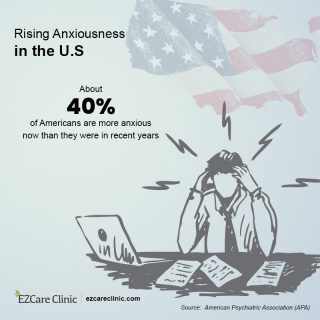
Rising Anxiousness in the U.S
How do you know that it’s an anxiety attack? You’ll experience some of these symptoms:
Psychological Symptoms
- Trouble concentrating
- Trouble sleeping
- Depression symptoms
- Memory difficulties
- Feeling overwhelmed
- Sense of impending doom
- Derealization
- Paranoid thoughts
- Imagining the worst
Physical Symptoms
- Restlessness
- Racing heart
- Sweaty palms
- Hot flashes
- Chest pain
- Chills
- Numbness and tingling sensations
- Frequent urination
- Nausea
- Dizziness/feeling faint
- Shortness of breath
Now that you recognize that you’re experiencing an anxiety attack, you can figure out how to manage the attacks.
Treat Anxiety symptoms effectively by clicking the button below!
2. Get an Emotional Support Animal
An emotional support animal, such as a dog, may be what you need to help you cope with your anxiety attacks. If you love dogs, you know that they’re loyal companions and will follow you around wherever you go.
This is what you need when having an anxiety attack. You need someone to help you calm down, and your emotional support dog will do so. If you need medication, you can train your dog to fetch your meds.
Emotional support animals are better than human companions in many ways, but arguably the best is that they don’t judge. They can even detect your anxiety attack before it strikes. If they can’t help, they can lead someone else to your position to help you out.
Also, having an emotional support dog that loves to cuddle will help you calm down. The presence of such a dog will help calm your heart rate and ultimately help you feel at ease. They are also distracting as they need to be cared for.
You’ll need to walk that dog, play with the dog, clean after it, etc. All these activities will help your focus on something else other than your anxiety.
Can you choose any animal as your emotional support animal? No. You can’t have a lion or polar bear running around your house as an emotional support animal. Preferably, you want a domesticated animal such as dogs, cats, snakes, spiders, miniature horses, rabbits, parrots, etc.
Choose an animal that you’re comfortable with as you want a support animal that contributes to your wellbeing.
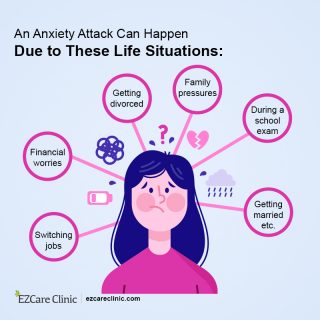
An Anxiety Attack Can Happen Due to These Life Situations
3. Anxiety Relief Diet
Aside from emotional support animals, you can try other anxiety relief strategies such as foods. Consult your dietitian and doctor to understand how your food affects your brain and lessens your anxiety.
Your first thought might have been stress eating, but it’s not the same. You see, you’re trying to go for a healthy diet, and stress eating typically involves junk food.
For your anxiety, you want to lower the amount of processed foods in your diet and opt for whole foods. Avoid binge eating, especially your favorite comfort food, as it only leaves you feeling guilty. Introduce such foods to your diet:
Salmon
A juicy steak would be hard to ignore, but you need foods rich in
Dark chocolate
Eating chocolate is associated with depression and said to relieve feelings of irritability and anxiety. It’s said that low serotonin levels cause anxiety. Fortunately, dark chocolate has tons of tryptophan; an amino acid considered a precursor to serotonin. This means that consuming dark chocolate could help uplift your moods and reduce anxiety levels.
Cheese
Some say that cheese is God’s gift to humanity, but not everyone agrees, especially if they’re lactose intolerant. It’s tasty food that goes well with almost everything. You can’t go wrong with cheese.
It’s great comfort food, but it’s caloric dense; thus, you might want to consume it in moderation. This will help reduce cortisol levels and enjoy a stress-free life.
Boost your mental health by clicking the banner below!
4. Clothing Matters
Some just wear clothes or whatever they can find without putting much thought into their appearance. This might not necessarily be the reason for your elevated anxiety levels, but your attire can affect your self-esteem, which is related to anxiety.
Your attire has little to do with your anxiety, but it says a lot about your confidence. Impressions matter and the first thing people notice when they meet you is your clothes. People judge you by what you’re wearing, which is why folks are always anxious when choosing clothes to parties, school, etc.
For some, dressing up doesn’t matter, especially if they spend their time locked up in their rooms. You might be right, but have you tried dressing up to see how it feels? If not, try it as you have nothing to lose.
Here Are Some Tips You Could Use:
Keep in mind that no magic button will get rid of your social insecurities and make you feel comfortable in your clothes. You have to change by yourself. Remember that you can’t control what others think of you, but you can change your dressing code. This might not necessarily change what they think of you, but it might alter what you think their thoughts of you are.
The changes you make need to be gradual. Start by getting a few shirts and wearing them frequently. Once you’re used to this, get a few pants, and throw out some of your clothes. Gradually get rid of that shy persona and become more confident around others.
Now that you have the clothes you need, create a schedule detailing the clothes you will wear for the different days. Remember to accessorize and get some shoes to match with the clothes. Make sure you look presentable, but that doesn’t mean that you have to wear official or fancy clothes. Simply wear what you want to feel for the day.
Get correct diagnosis for anxiety symptoms by clicking the button below!
5. Manage Your Anxiety With RAIN
The first instinct, when faced with difficult emotions, is to suppress whatever you’re feeling. It’s effective but only for a while. Society expects you to be happy and perfect, but this rarely happens.
Even with anxiety, you’re expected to handle and control it, but as you might have experienced, it’s hard to do so. This doesn’t need to be your life as you can embrace RAIN. It’s a technique developed by Michelle McDonald to support people struggling with difficult and intense emotions.
RAIN is an acronym that represents the four steps involved in the technique:
Recognize
Recognize what you’re feeling or experiencing with an open mind. Don’t be too aggressive on yourself by
A simple recognition opens up your mind and allows you to feel present in the moment.
Accept
Now that you know what is happening, the next step is that you need to acknowledge it. Don’t try to avoid it or suppress what you’re going through. This is your reality, and don’t try to tuck it under the rug until it next resurfaces.
Investigate
This step calls on your desire to know why your anxiety attacks occur. You’re taking a more proactive approach, trying to figure out the cause of your experience.
Take a minute to question what is happening to you. This simple question can ignite your curiosity and take you down the path to figuring out why this happens.
Non-Identification
Although what you’re experiencing is hard, it’s not who you are, and it doesn’t define you.
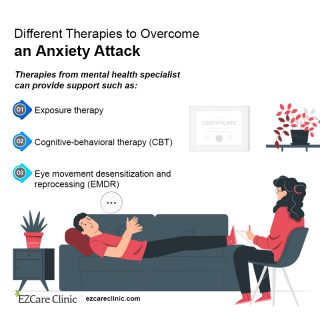
Different Therapies to Overcome an Anxiety Attack
6. Deep Breathing
When having an anxiety attack, one of the most common symptoms is
You’ve probably been told severally to take a deep breath every time you experience shortness of breath. While this information is useful, it doesn’t really help.
You see, when you’re experiencing shortness of breath, your first instinct is to take short, shallow breaths. If you attempt to take a deep breath, you’ll most likely take a shallow breath. It will provide you with the necessary amount of air needed, but it doesn’t feel the same as taking a deep breath.
Your deep breaths are not working because you’re missing a critical step – you’re not exhaling. Start by exhaling, then take a deep breath and see if you’ll notice the difference.
When you take a deep breath, your brain will interpret this as you wanting to calm down. It will then send this message to the rest of your body to relax. The more you continue to breathe deeply, the more your anxiety levels lower, and all the attack begin to decrease.
There are tons of deep breathing techniques, and they include:
Belly breathing
Lie down in a comfortable position, place one hand on your chest and another on your stomach. Take a deep breath as your belly pushes against your hand. You want to breathe in via your nose, but when breathing out, use your mouth as if you’re trying to whistle.
Push your hand against your belly until you’ve pushed out all the air. Repeat this exercise about ten times or until when you’re feeling relaxed.
Get rid of anxiety problems by clicking the button below!
7. Aromatherapy
Your sense of smell and your brain are intertwined. This is why when you encounter certain scents, they evoke emotions or memories. It could be a previous relationship or a memory of you and a loved one or an event. Aromatherapy is an ancient practice that dates back to ancient China, Egypt, and Rome. Some of the essential oils used to relieve anxiety include:
Lavender
Lavender is a popular oil and the first choice for many seeking to try aromatherapy. It has a soothing scent that’s a natural remedy for anxiety and will help you relax. It’s also a remedy for insomnia.
Jasmine
Jasmine has a floral scent that promotes a sense of romance, wellbeing, and reduces anxiety. Unlike lavender, which causes sleepiness, jasmine oil reduces anxiety levels without affecting your sleep.
Sweet Basil
Sweet basil is said to have anti-anxiety properties similar to diazepam. It also has antidepressant properties and boosts mental health. It’s said to improve stress-related sleep, prevent age-related memory loss, etc.
Geranium
The aroma of geraniums can reduce anxiety levels even in women during childbirth. It also has an antidepressant effect, which is effective against anxiety, tension, and sadness.
Ylang Ylang
Ylang Ylang is typically used in aromatherapy to alter self-esteem perception, promote relaxation, and lower anxiety levels.
Patchouli
Patchouli is often combined with lavender to promote calmness, relaxation, and relieve anxiety. If you’re just starting out, try lavender, it’s a popular essential oil, it’s effective, and those who’ve used it are fond of it.
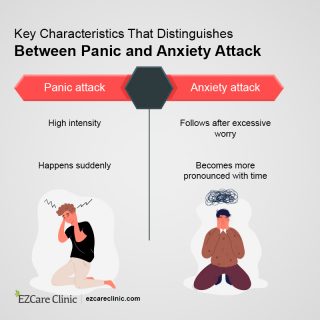
Key Characteristics That Distinguishes Between Panic and Anxiety Attack
8. Visualization
Visualization involves the use of mental imagery to help you unwind and cope with your anxiety attacks. In simple terms, you’re imagining yourself in your happy place. It might sound silly, but it’s actually very effective.
You’ll close your eyes and transfer your mind to your happy place long enough to distract yourself from your anxiety attack. However, it takes practice to master this technique. You need to do it repeatedly until you perfect it.
Simply closing your eyes and thinking of your happy place won’t cut it. You’ll need to activate all your senses and imagine more than just how that place looks. For example, you want to imagine how it smells, how it sounds, and how it makes you feel.
Keep in mind that visualization can affect your mental health positively or negatively. It’s effective whichever way you choose to utilize it. For example, if your mind escapes to thoughts that make you anxious, it will only worsen your anxiety levels.
Find your safe space and begin to practice your visualization techniques.
9. Distraction
Distraction is a technique used in cognitive-behavioral therapy as a remedy for anxiety. The idea of distraction is to help you focus on anything else other than what you’re experiencing. It’s simple but effective.
For example, you can count the objects around you and detail what they look like. You can also attempt to count numbers backward from 20 to 0 or 50 to 0.
There are tons of distraction techniques but be sure to focus on healthy techniques only. You’ll find some using unhealthy techniques that involve self-harm or drug use. If you find yourself gravitating towards such tendencies, seek help.
Start your treatment to overcome anxiety by clicking the banner below!
Utilize techniques such as:
- Spend Time with Someone or Something You Love: Distract yourself by talking to someone you enjoy spending time with. It could be your partner, friend, family member, etc. If you own a pet, get some cuddles or play with the dog to distract you from the anxiety attacks.
- Use Entertainment: Read a book, magazine, novel, or something like that. If that isn’t your taste, try watching a movie or listening to charming sounds.
- Play Sports: Try playing a sport you’re interested in such as football, basketball, etc.
- Physical Exercise: Head to the gym and get done with your workout for the day. Think about it, if you’re squatting 300 or so pounds for reps, the only thing you’ll have on your mind is perfect form and completing your reps.
- Draw Or Color: Get a drawing or adult coloring book. Sit down and work on your drawing or coloring skills.
- Play Video Games: Video games are immersive and very distracting. Pick your favorite games and get started as you typically would.
10. Practice Mindfulness
Anxiety is typically a response to a perceived threat, which means you’re worried about something that may happen in the future. This takes you away from the richness of the moment as you spend your time worrying about something that might happen.
Most of the things you’re worried about you’ve experienced before, and you’re still here. Remember that time you were late for a meeting or event? It wasn’t as bad as you anticipated, was it?
It’s alright to worry, but you don’t have to focus on it like it’s the only way. Instead, try to enjoy the moment, and this is where mindfulness comes into play. It helps you learn to trust these feelings of discomfort and create space around them such that they won’t consume you.
Mindfulness doesn’t mean that you should change what you’re thinking. Its purpose is to help you become intimately aware of your thoughts.
How Do You Practice Being Mindful?
Take a few minutes off your busy schedule and focus on your breath. How does it feel as you breathe in, your chest rises and falls? Focus on that sensation as you breathe in and out. If your mind strays, return to this moment. You want to feel this moment, how good it feels to be alive.
If you don’t reap the benefits, keep trying, and eventually you’ll know what works for your mind.
Deal anxiety with efficacy by clicking the button below!
11. Positive Muscle Relaxation
Positive muscle relaxation is a technique that was introduced in the 1920’s to help people with illness anxiety disorders relax. It’s not uncommon to tense muscles when you’re anxious; thus, this technique seeks to help you control your body’s anxiety response.
When you’re faced with a threat, your brain activates its flight or fight response. This often involves muscle tension, stiffness, elevated heart rate, etc. which are triggered by anxiety and stress.
You can reverse these effects by using positive muscle relaxation techniques to lower your heart rate, reduce body tension, and calm your mind.
How Does Progressive Muscle Relaxation Work?
The first and most critical step is that you need to get comfortable. You can lie down or sit in a chair but ensure that you’re in a relaxing position and free from distractions. Now that you’re comfortable breath in deeply through your nose and exhale via your mouth. Do this about 3-5 times.
The next step involves tensing and relaxing muscles. You’ll start with your feet by clenching your toes. This works better if you’re bare feet as you’re able to clench your toes tightly while pressing your heels against the ground.
Release the clench with the toes pointing upwards, hold this position for several seconds and release. Work your way to the rest of your muscles from your calves to the face. Tighten each muscle and release. Repeat this with all muscle groups that feel stiff.
If you’re injured, avoid tensing muscles in areas that are in pain as you might worsen your injury.
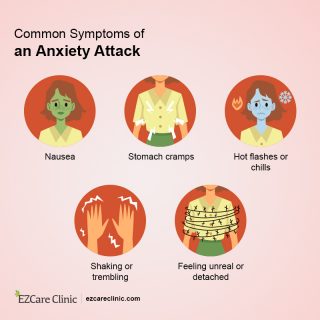
Common Symptoms of an Anxiety Attack
12. Open Up About Your Condition
Opening up about anything to friends, family, or even colleagues is tough. There is just so much you have to think about. How will they react? Will they treat you the same? Will they see you the same?
It’s tough enough; they know that you’re struggling with something but talking about it is a different thing altogether. However, remember that these are your family, friends, and people who care about you.
The most effective way to get help is to ask for it. Go to your family, friends, or your partner and talk to them about what you’re going through.
If your anxiety attacks keep occurring at work, you can talk to your work buddies or even your manager. This might be scary compared to talking to your family, but it might get you the help and support you need at your workplace.
You’ll feel relieved, and if your triggers are things that occur at your workplace, you can talk with your colleagues and figure out how to reduce these triggers. You’re not necessarily hoping that the people around you will work as if they’re walking on eggshells not to trigger you. Instead, what you need is a safe workplace where everyone feels comfortable and productive.
Talking to others about your conditions helps a lot, so don’t shy away from trying it. You might even be surprised that you’re not the only one struggling with this at home or the workplace. Besides, keeping things to yourself only adds to the feeling of loneliness and isolation.
You feel like you’re all alone, and it’s the worst possible feeling as you feel like
Although talking to friends, family, and colleagues is beneficial, be sure to talk to a professional such as a therapist. The help from your family, friends, and colleagues will only go so far; thus, you’ll need additional support from a professional.
Treat psychiatric problems now by clicking the button below!
13. Recite Your Mantra
In the animation “Cars,” the character Lightning McQueen psyches himself up before a race by reciting his “I am speed” mantra. Every time he’s about to hit the tracks, he recites his mantra to help him focus and do what he does best-winning.
This is the idea of a mantra; it helps you focus or calm down when experiencing an anxiety attack. You keep repeating it until your body calms down, your heart rate slows, and breathing resumes normalcy. Try mantras such as:
This too shall pass
You’ve probably heard this line in movies or your life. It’s a saying that people say to others when they’re going through a tough time. It’s arguably the most powerful mantra for anxiety or panic attack.
Think about it; your anxiety won’t last forever. It sets in and feels like the worst feeling ever but eventually subsides. It’s an intense feeling, but it shall pass, and you should remind yourself that it shall pass.
All is well
You can learn a few things from the movie “3 Idiots”. The main character Rancho, recites “all is well” every time he is faced with a challenge. It doesn’t solve his problem, but it gives him the guts to face it.
Try reciting these words every time you have an anxiety attack. Things might not go as you like but remind yourself that all is well.
It’s okay not to be okay
Everyone feels down at some point, and you feeling anxious, stressed, or depressed is part of life. It’s difficult to deal with these emotions, but it’s not the worst thing that can happen. You can’t be calm, happy, and relaxed all the time.
It’s okay to experience what you’re experiencing, don’t try to suppress it, instead choose to learn to control it.
Everything will be alright
You won’t feel anxious forever, it will end, and you’ll feel good again. Reassure yourself that everything will be alright and ride it out.

7 Foods That Help Reduce Anxiety
14. Anxiety Medication
Anxiety feels unpleasant and sometimes even unbearable. It might have crossed your mind that you should try anti-anxiety pills. You’ve probably watched tons of ads promoting anti-anxiety pills, and you’re wondering if you should try them.
Yes, anti-anxiety medication is good; it helps relieve your anxiety and stress; however, this should be among your last options. You want to try other anxiety-relieving techniques such as those listed above.
Also, try to figure out which form of anxiety disorder you’re struggling with. Some of these include phobias, social anxiety, separation anxiety, panic disorder, post-traumatic stress disorder, etc.
Once you know what you’re struggling with, you can explore measures to manage it. These measures include medication, which you’ll need to consult a mental health professional to get the right prescription.
Keep in mind that medication isn’t a magic bullet that will suddenly make things better. You’ll need to combine it with other interventions to make it work as it should. One of these interventions is therapy; however, it’s too expensive, and most people don’t have the finances to commit to such treatment options.
Seek cheaper options, such as lifestyle change. The simple things matter, so don’t ignore the recommended sleep hours, healthy eating, and exercise. If you feel overwhelmed with anxiety, it might be time to get your medication.
Some of the common anti-anxiety medications include:
- Benzodiazepines such as Klonopin, Xanax, Ativan, etc.
- Selective serotonin reuptake inhibitors
- Tricyclics
- Beta-blockers
- Buspirone
Remember, medication isn’t your sole option; thus, if you can, avoid it as some of these have side effects.
Obtain optimum mental health by clicking the banner below!
15. What Is Triggering Your Anxiety?
It’s not uncommon to experience an anxiety attack with no apparent cause. Still, over time you’ll come to realize that these anxiety attacks are often as a result of actions or situations. Some of these include:
Underlying health issues
Any time you have a health problem, you’re always worried that it might worsen. The same applies when waiting for a diagnosis. There is just so much on your mind as you don’t know how it will turn out. Your condition may be getting better or worsening. This is too much to process, and you could find yourself experiencing a full-on panic attack.
Becoming a parent
This is one of the joys of life as you’re welcoming a baby into your family. You’ll have highs and lows, but it will be worth it. However, you might find yourself overthinking about the things that could go wrong, leading to an anxiety attack.
Caffeine
Some people need caffeine to function, but it could be worsening your condition. If it’s the trigger to your anxiety, you might want to switch to non-caffeinated alternatives.
Financial difficulty
You’re employed or running a business to get money, and if your income stream is threatened, it could affect your mental health. If you lose your business, job, or income stream, you’ll begin to stress about financial issues such as how you’ll survive.
To limit the possibility of an anxiety attack, talk to someone about your situation.
Get your treatment for various mental issues by clicking the button below!
16. Limit Stimuli
What is stimulating your anxiety attacks? It could be something as trivial as bright lights, but you’ve been ignoring it. Look at your surroundings and figure out what is stimulating your anxiety response.
For example, you can have a separation anxiety disorder, leading to an anxiety attack every time you’re separated from a person you’re attached to. This is typically seen in kids, and one of the effective remedies is to practice goodbyes.
If your child gets anxious when you leave, try leaving them with someone they’re comfortable with, spend some time outside, and then come back. Over time your child will begin to trust that you’ll return.
Another example is traffic jams. There is nothing as annoying as an unexpected traffic jam, especially when you’re in a hurry. The more you’re stuck in traffic, the more you get anxious as it’s messing up your schedule.
Picture yourself stuck in traffic when heading to an interview or exam. Within a few minutes, you start getting worried that you’ll be late, and there is little you can do about it. You feel so powerless in this moment, and you’ll resort to worrying, and it eventually turns into an anxiety attack.
Other common stimuli include noisy neighbors, alcohol abuse, a bad day at work, skipping meals, etc.
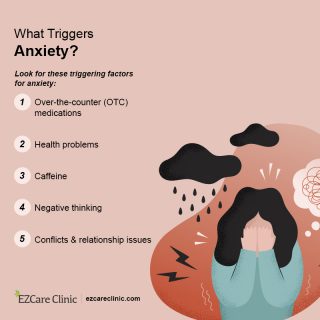
What Triggers Anxiety?
17. Exercise
When you’re angry, you’re occasionally told to walk it off to help ease some of that anger. It works wonders because it takes just a second to do something stupid that you’ll regret. However, if you were to take a walk for several minutes, you’ll have time to contemplate what you’re about to do and the consequences. That should be more than sufficient to set you straight.
The same principle is applied to anxiety as you’re trying to relax, ease some of that tension, reduce your heart rate, etc. Physical activity also helps distract you from what you’re experiencing.
You don’t need to spend the entire day working out when a simple run, swim, or dance will do the trick. Also, remember not to exert yourself too much and
7 Ways to Help Someone Having a Panic Attack
If a person close to you is experiencing an anxiety attack, here are some tips that might come in handy:
1. Stay with the person
Naturally, your first instinct would be to seek help from a professional, but sometimes the best help is to remain calm and stay with the person.
2. Relocate the person
As mentioned earlier, external stimuli affect people with anxiety; thus, you might want to move the person to a place/room with no stimuli. Ask the person whether they’d like to stay or move to a quieter and more private room.
3. Offer medicine
If the person has medicine or takes medication during an attack, you can offer medication. Be sure to ask before picking up just any medication you find.
4. Talk to the person
Engage in a friendly conversation and let them know that you’re there to help. It’s even better if you’re friends as you can engage them in a topic they like.
5. Suggest breathing techniques
Help the person calm down by suggesting some of the breathing techniques discussed in an earlier section.
6. Don’t jump to conclusion
Don’t assume anything; always ask even for when you’re trying to offer help. Ask if they need any assistance and what they’d like you to do.
7. Be patient
Don’t try to be condescending or belittle their experience. Instead, be a supportive friend and focus on how you can assist. Also, don’t tell them to calm down or relax; instead, use words of affirmation such as, “you can do this,” “you’re doing great,” etc.
A positive & healthy approach can treat anxiety issue – click the button below!
Final Thoughts
Anxiety attacks are scary, and people around you might not know how to help; fortunately, we’ve detailed 17 tips that can help you overcome your anxiety. Use this and any other resources to educate those around you about what you go through and how they can help through proper anxiety care plan.
Visit EZCare Clinic or call us today to book an appointment with us!
Sources
- Omega-3 fatty acids for mood disorders. (2020)
Source link - Dual Diagnosis: Substance Abuse and Mental Health
Source link - SHORTNESS OF BREATH: ANXIETY OR CORONAVIRUS? (2020)
Source link - What to know about abandonment issues. (2023)
Source link - Exercise for Stress and Anxiety
Source link





